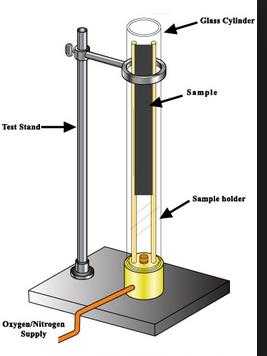limiting oxygen index Methods

Oxygen index methods, which describes the tendency of a material to sustain a flame, are widely used as a tool to investigate the flammability of polymers. They provide a convenient, reproducible, means of determining a numerical measure of flammability. A further attraction is that the test method uses inexpensive equipment and only requires a small sample size. These methods have been used to systematical investigate the relative flammabilities of fire-retarded materials, frequently comparing the effectiveness of fire-retardants and fire-retardancy mechanisms.

The limiting oxygen index (LOI), also called the critical oxygen index (COI) or oxygen index (OI), is defined as:
LOI = [O2,cr] / [O2,cr] + [N2]
where [O2,cr] and [N2] are the minimum oxygen concentration in the inflow gases required to pass the ``minimum burning length'' criterion and the nitrogen concentration in the inflow gases respectively. If the inflow gases are maintained at constant pressure then the denominator of equation~(1) is constant since any reduction in the partial pressure (concentration) of oxygen is balanced by a corresponding increase in the partial pressure (concentration) of nitrogen. Limiting oxygen index is more commonly reported as a percentage rather than fraction.
Since air comprises about 20.95% oxygen by volume, any material with a limiting oxygen index less than this will burn easily in air. Conversely, the burning behaviour and tendency to propagate flame for a polymer with a limiting oxygen index greater than 20.95 will be reduced or even zero after removal of the igniting source. Self-sustaining combustion is not possible if LOI>100, such values are not physically meaningful.
2018-02-02 14:49

